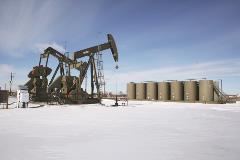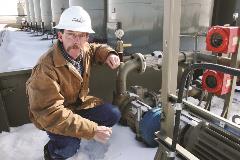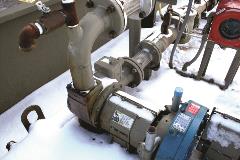BLACKMER® X SERIES SLIDING VANE PUMPS HELP SLAWSON EXPLORATION AND PELICAN GATHERING SYSTEMS OVERCOME HANDLING CHARACTERISTICS OF BAKKEN-PRODUCED CRUDE OIL THAT ARE RARE IN THE INDUSTRY
By Doug Cumpston
Quick Facts
- Company: Slawson Exploration Co., Inc. & Pelican Gathering Systems, LLC
- Location: New Town, ND, USA
- Market: Oil & Gas
- Challenge: Overcome the handling characteristics of Bakken-produced crude oil
- Solution: Blackmer® X Series Sliding Vane Pumps
In late 2014, the United States became the world’s leading producer of natural gas. In other news, up is down, dogs can talk and the sun now rises in the west. Okay, maybe the ongoing boom in domestic oil and natural gas production—which is being driven largely by historic recovery rates in the nation’s shale plays, particularly the Bakken in North Dakota—isn’t as dramatic as those last three examples, but it has forced a change in the way the industry is being perceived.
This change in perception not only concerns the noteworthy amounts of oil and natural gas that are being produced, but how and where they are being recovered, along with the makeup of the commodities and how that affects their handling, transport, storage and refining.
“It’s a left-brain, right-brain type of situation,” said Tom Roberts, Field Supervisor for Pelican Gathering Systems, LLC, New Town, ND, USA. Pelican is a subsidiary of Slawson Exploration Company, Inc., Wichita, KS, USA. “What they’re doing up there in the Bakken in North Dakota is on a bigger scale than what I’ve seen before because what they do is have six to eight well bores on one site with huge tank batteries. One site might pump 2,000 to 2,500 barrels off-site because of so many well bores. It’s an entirely different way of doing things.”
Roberts knows of which he speaks. For the 15 years prior to his joining Pelican, he worked on a 500-mile 16-inch pipeline system that bisected New Mexico from northwest to southeast and into Texas. In that case, the commodity being transported was traditional West Texas Intermediate crude oil. Since moving north, he has discovered that Bakken crude is an entirely different animal. Specifically, it can be defined as a “three-phase” liquid in that it is of a light viscosity with a high concentration of entrained natural gas and other components that affect its specific gravity from day to day.
“The oil and gas does not separate well and that poses some different handling issues; anytime you pump crude with a lot of entrained gas, it’s more difficult to pump,” explained Roberts. “That vapor pressure is not that easy on pumps and you have to keep them pretty well fed with good head pressure so they’ll continue to pump.”
Banking On The Bakken
Slawson Exploration is a privately held oil-and-gas exploration company that was founded in 1957 by Donald C. Slawson. Since its inception it has drilled more than 3,500 wells in 10 states. Its current exploration and production operations in the Bakken are centered near the New Town, ND, area, which is located near Lake Sakakawea, 70 miles east of Williston and 140 miles northwest of Bismarck. Once Slawson’s Bakken oil and natural gas are produced, they are transferred from the wellhead into a Pelican pipeline system, which moves the commodities to one of four delivery points: a pair of rail terminals near New Town or two connection points with other pipeline companies.
Since initiating its Bakken operations in late 2012, Slawson has produced more than 10 million barrels of Bakken crude oil, with 930,000 barrels alone recovered in January 2015.
To transport the produced products, Pelican uses polyethylene pipeline that has a maximum working pressure of 125 pounds per square inch (psi). Once the commodities reach the pump stations, however, steel pipe with a rating of 600 psi is used to move them into storage tanks, with 6,400 to 12,800 barrels of storage space located on-site. From the storage tanks they are eventually transferred to railcars that take them to the next link in the supply chain.
Critical to the effective operation of this transport, delivery, transfer and storage system are the pumps that are used to introduce the oil and natural gas into the pipeline at the wellhead, transfer it through a series of switching stations located along the pipeline and then deliver it to the storage tanks.
“The pipeline itself has a 125-pound working limit and some of the pipe runs are quite long with many laterals so pressure consistency is very important to keep well production at its optimum,” said Mark Williams, Corporate Account Manager for Farmington, NM, USA-based Horizon Power Systems, a designer, fabricator and servicer of oilfield production equipment and systems. “The inlet pressure to the pipes can vary a lot according to the tank-battery level and how much gas is entrained in the oil. This can result in vapor-lock conditions if the pump is not able to work through upset conditions.”
Slawson was using a brand of gear pumps in these critical applications, but Roberts had begun to notice that their operation would begin to be compromised when the vapor pressures varied too much, which hampered the overall efficiency of the pipeline operation.
“The thing about the gear pumps is they are more particular when talking about vapor pressure; they need the right head pressure to keep a constant flow,” he said. “I had a lot of calls from the field where my guys were saying that the pump’s vapor-locked and there are still five feet of product in the tank.”
The Perfect Pumps For The Process
In the search for a solution, Roberts reached out to Williams and Horizon Power Systems.
“Tom asked me what I thought was the best pump to handle an oil that had a lot of entrained gas and also had a very low viscosity and after doing some research we decided that using the Blackmer pumps would be a very good offer, so we developed a package that Slawson wanted,” said Williams.
Specifically, Williams recommended X Series Sliding Vane Pumps from Blackmer®, Grand Rapids, MI, USA, which is a product brand of PSG®, a Dover company that is based in Oakbrook Terrace, IL, USA. The design and operation of X Series pumps makes them ideal for handling high vapor pressure petroleum products. Their operational features include sliding-vane design that self-adjusts for wear to maintain flow rates; self-priming and dry-run capabilities; adjustable relief valve that protects against changing and excessive pressures; and easy vane replacement and maintenance that does not require the pump to be removed from the piping system.
“One of the other advantages of Blackmer pumps, in this case, is that they have had the experience in pumping high-pressure liquids like propane and butane,” said Williams. “The vane-type pump is very kind to the fluid and it doesn’t break out the gases from the liquids as badly as a gear pump or centrifugal pump would.”
Slawson is using three sizes of X Series pumps—1.5-, 2- and 3-inch or, in Slawson’s vernacular, 1, 2 and 5 barrels-perminute (bpm) models—with the pump, motor and gear case installed on a skid that has the suction and discharge piping terminated at the edge. The skid is also outfitted with all necessary valves, instrumentation and caps. The skids are then installed at the tank batteries. Currently, Slawson is utilizing 60 to 70 skid-mounted units that are outfitted with Blackmer X Series pumps.
“Not only do you not really have any vapor issues, but the ease of maintenance and repair is pretty remarkable, in my opinion,” said Roberts. “We took two or three guys and made them pump-repair guys on these Blackmer pumps and they can go service these pumps everyday. We’re running them really hard so they need routine maintenance for bearings and things like that, and in less than two years those guys were able to take a rebuild kit and call two hours later and say, ‘You’re ready to go.’ That’s a big advantage compared to having another brand of pump that made it necessary that I call somebody from another distributor and wait for the technician to drive two hours from Bismarck to come fix the pumps. The downtime on the Blackmer pumps is pretty small; we can fix something that is completely down and be back up and running in less than two hours.”
The X Series pumps are also able to handle the harsh operating conditions found in the Bakken, where temperatures can reach -50ºF (-46ºC). Their methods of construction and operation, and use of mechanical seals, also eliminate product leaks that could potentially foul the environment, which is a constant concern for oilfield operators.
“We take a lot of care that the pumps are properly vented on their skids so that they don’t make a mess and will continue to lower the environmental impact,” said Williams. “When we built our skids with the Blackmer pumps we took a lot of care to make sure that any environmental impact was as controllable as possible.”
“The skids, as far as they are designed, can’t be improved much,” added Roberts. “Whoever designed the skids was thinking about day-to-day use, environmental problems, things like that.”
The positive impact of the Blackmer pumps has been so pronounced that Roberts is seriously contemplating taking the 30 or so skids that still feature gear pumps and switching them over to Blackmer X Series models.
“That’s one thing I can compare performance-wise, how the pumps perform in relation to something else,” said Roberts. “As we look at what we can do better, that would be one of the things, picking off those gear pumps. If we have a gear pump on its last legs, sure they can be rebuilt, but more frequently you just replace the pump. With what we’ve seen from the Blackmers, it would make us look pretty hard at replacing the gear pumps with Blackmers.”
Conclusion
The historic leap in United States oil and natural gas production has not only necessitated a new way of viewing the industry, but a new way of attacking its challenges. The rare characteristics of Bakken shale crude oil has created the need to identify pumping technologies that can work in unison with its various levels of entrained gases and low viscosity. After years of working to find the right solution, Slawson Exploration and Pelican Gathering Systems have found the best pumping technology for their pipeline applications: X Series Sliding Vane Pumps from Blackmer.
“Once you get the Blackmer pumps started, you don’t have to worry about any issues,” marveled Roberts. “They pump it down to whatever level you have in mind, which makes our job easier. We don’t have to do much with the Blackmers, just set them, connect them, power them up and they’re ready to go.”
About the Author:
Doug Cumpston is Director, Sales & Business Development North America Energy for PSG®. He can be reached at +1 303-766-2755 or Doug.Cumpston@psgdover.com. Blackmer is a leading brand of rotary vane and centrifugal pump and reciprocating compressor technologies from PSG®, a Dover company. Headquartered in Oakbrook Terrace, IL, USA, PSG is comprised of several leading pump brands, including Abaque®, All-Flo, Almatec®, Blackmer®, Ebsray®, Griswold™, Mouvex®, Neptune™, Quattroflow™, RedScrew™ and Wilden®. For more information on Blackmer or PSG, please go to blackmer.com or psgdover.com.

Since initiating its Bakken operations in late 2012, New Town, ND, USA-based Pelican Gathering Systems, a subsidiary of Slawson Exploration Company, Inc., has produced more than 10 million barrels of crude oil. Critical to the effective operation of the company’s transport, delivery, transfer and storage system is the pumping equipment, and the pump of choice for Pelican Gathering Systems is Blackmer® X Series Sliding Vane Pumps.

The rare characteristics of Bakken-produced crude oil creates the need to identify pumping technologies that can work in unison with its various properties, including high levels of entrained gases and low viscosity.

As part of his responsibilities, Tom Roberts, Field Supervisor for Pelican Gathering Systems, monitors the Pelican pipeline system, which utilizes pumps to introduce the oil and natural gas into the pipeline at the wellhead, transfer it through a series of switching locations along the pipeline and then deliver it to the storage tanks.

Blackmer® X Series pumps are able to handle the harsh operating conditions found in the Bakken, where temperatures can reach –50ºF.
After years of working to find the right pumping solution to handle Bakken crude, Slawson Exploration and Pelican Gathering Systems found the best solution in Blackmer® X Series pumps.